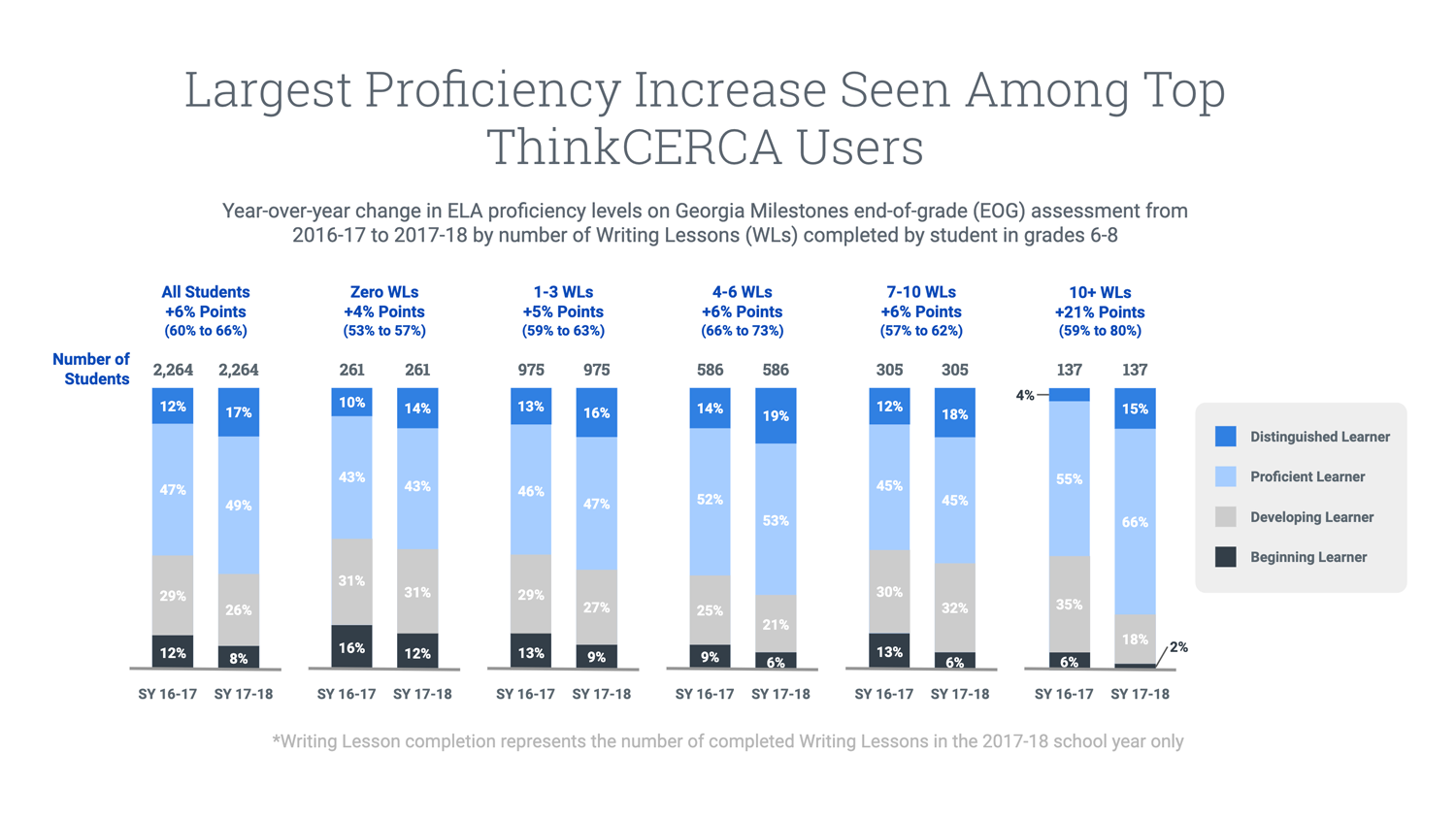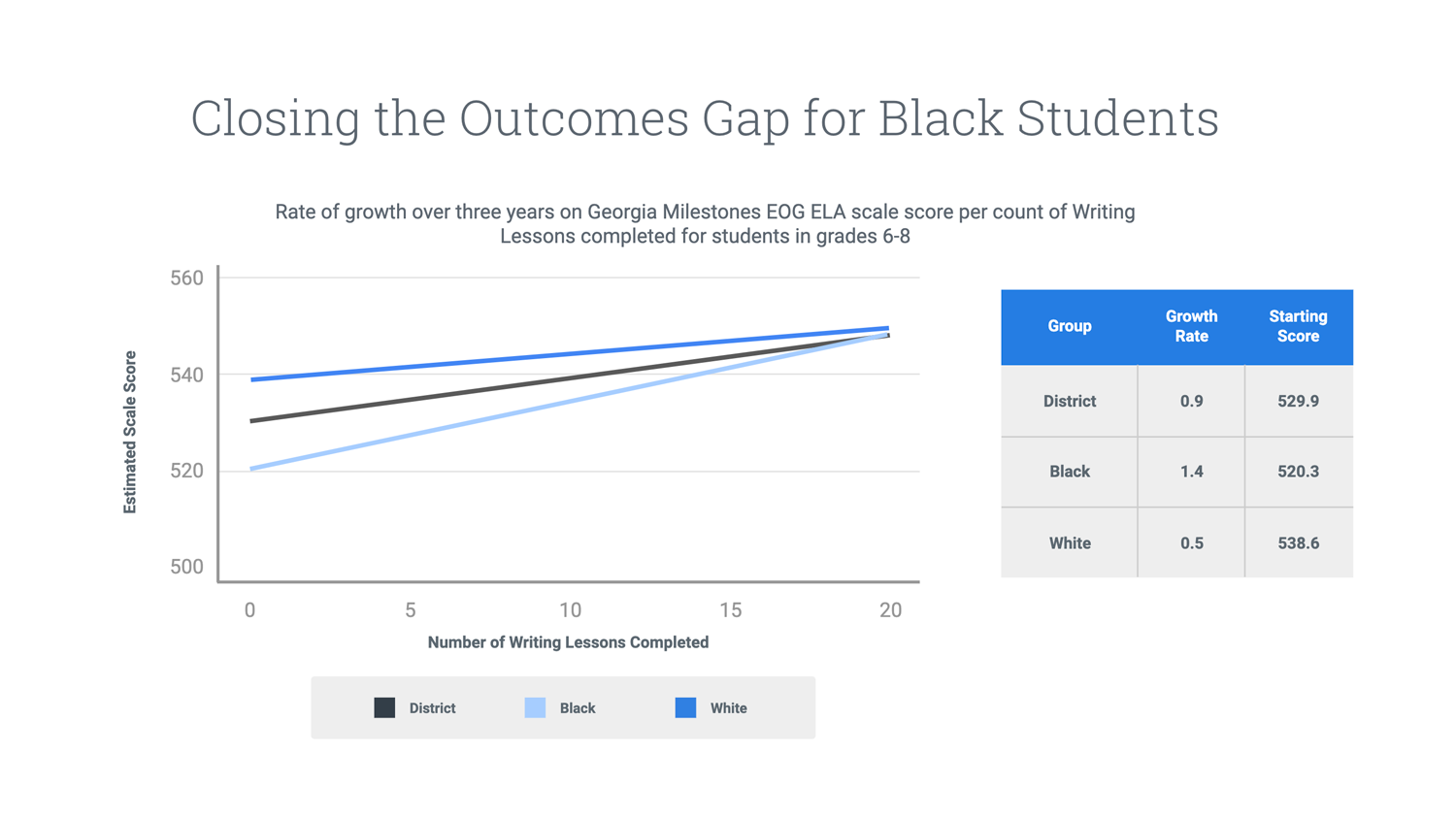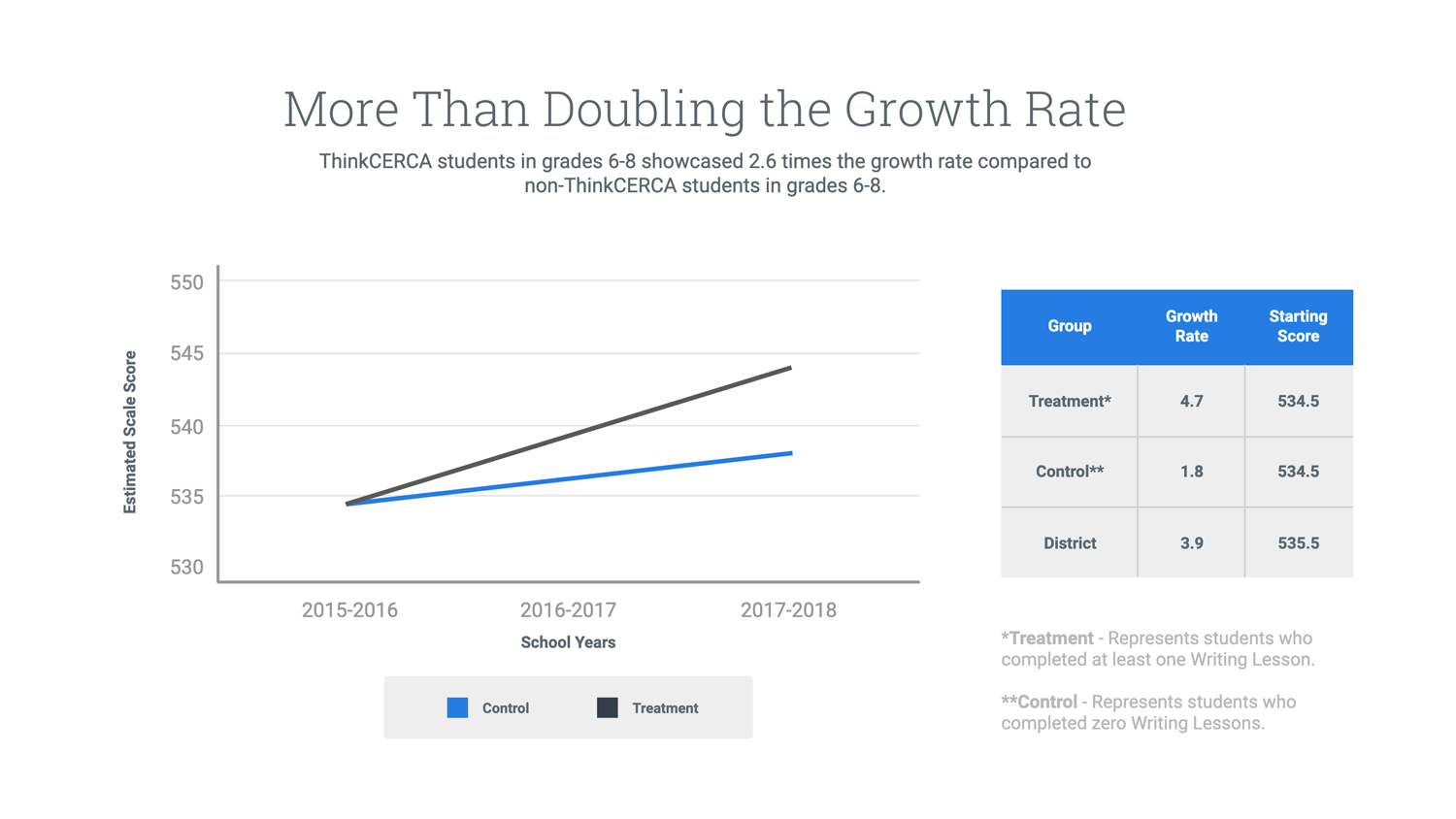Multi-year Case Study
Closing Gaps with Literacy Across the Curriculum
At Fayette County Public Schools, students who used ThinkCERCA demonstrated 2.6 times the growth of peers who did not use ThinkCERCA.
Key Takeaways
An analysis of three years' worth of ThinkCERCA and Georgia Milestones data found that:
- Test scores and proficiency levels trended upwards as Fayette students completed more Writing Lessons in ThinkCERCA.
- ThinkCERCA usage is helping to close the outcomes gap between black and white students at Fayette County Public Schools.
- ThinkCERCA students showcased 2.6 times the growth rate on Georgia Milestones compared to non-ThinkCERCA students.
Download the Case Study
District Demographics
25%
Eligible for Free/
Reduced Meals
49%
Female
51%
Male
48%
White
28%
Black
12%
Hispanic
6%
Asian
5%
Multiracial
1%
Native American or Pacific Islander
Download the Case Study
The Challenge
In recent years, many states have updated their standards and assessments to place greater focus on literacy and critical thinking. These efforts reflect decades of research which shows that when students consider evidence, explain their reasoning, and write across subjects, they comprehend material better.
Updating standards and assessments is just one step in the effort to teach students critical literacy skills, though. For district leaders, figuring out how to empower teachers, students, and administrators to meet the challenge of new standards is another.
"When you give all students that high level of expectation, you help them achieve what is possible."
In 2015, Fayette County Public Schools in Georgia embarked on an initiative to implement a rigorous literacy curriculum throughout the district. While Fayette has traditionally been one of the best-performing school districts in the state, “We had some concerns that we weren’t achieving at the highest level anymore,” said Dr. Joseph Barrow, the superintendent of Fayette County Public Schools. “We had not really focused on the literacy standards in our district very well.”
The district leadership team knew that a change was needed to prepare for new assessments, close opportunity gaps, and raise the rigor of instruction within all content areas. In the 2015-16 school year, the district made strategic shifts in instructional practice to expand student outcomes through a deeper focus on literacy across the curriculum.
The Implementation
Beginning in August 2015, Fayette County incorporated ThinkCERCA into its five middle schools to support reading and writing skill growth across content areas.
After the 2015-16 school year, ThinkCERCA was expanded to grades 6-12 in the district. As the initiative progressed, ThinkCERCA usage did as well. By incorporating ThinkCERCA into their instruction, teachers who were not previously accustomed to developing students’ reading and writing skills had the necessary tools, curriculum, and guidance to support literacy growth in every discipline.
“We knew that we really wanted to change from the mindset of a reading class to a literacy mindset throughout the whole day,” Caroline Schmitt, the district’s Coordinator of Reading & Language Arts K-5 said. “The science teacher might not be an English teacher, but he is a literacy teacher.”

The ThinkCERCA Curriculum provided English language arts, social studies, science, and math teachers with a wide range of differentiated close reading and academic writing lessons that aligned to Georgia’s standards.
The platform’s Writing Lessons walked Fayette students through the process of reading a text closely to construct a cohesive argumentative, informational, or narrative piece of writing across subjects.
“ThinkCERCA’s the tool that took the idea of literacy and put something in teachers’ hands to help them understand what it is, what it looks like,” Schmitt said.
By making literacy a regular part of classroom instruction, students were well-equipped to demonstrate a deeper level of comprehension on the state assessment, Georgia Milestones.
The Results
To understand the full impact of the multi-year literacy initiative, ThinkCERCA worked with Fayette to analyze the effect of ThinkCERCA usage on Georgia Milestones performance.¹
The analysis found that test scores and proficiency levels trended upwards as Fayette students completed more lessons. It also showed that ThinkCERCA usage is helping to close the outcomes gap between black and white students at Fayette. Additionally, based on matched comparison groups, ThinkCERCA students showcased 2.6 times the growth rate on Georgia Milestones compared to non-ThinkCERCA students.
Overall Impact of ThinkCERCA
Georgia Milestones measures student achievement at one of four achievement levels: beginning, developing, proficient or distinguished learner.
From the 2016-17 to 2017-18 school year, the students who scored “proficient” or “distinguished” on Georgia Milestones improved by six percentage points across the district. However, when these results were broken down by ThinkCERCA usage, a clear pattern began to emerge.

This dataset encompasses students who were present in the 2016-17 and 2017-18 school years and were also active on ThinkCERCA. This analysis focuses on Writing Lessons usage in the 2017-18 school year and compares test scores between the two years.
The group of students who completed zero Writing Lessons on ThinkCERCA saw a four-percentage point gain in proficiency from the 2017 to 2018 assessment. Of the group of students who completed 10 or more Writing Lessons, the percentage achieving proficiency improved from 59 percent to 80 percent.
Furthermore, for the students who completed 10 or more Writing Lessons, the percentage earning the top score of “distinguished learner” increased from four percent to 15 percent.
Closing the Outcomes Gap
Across the district, the number of Writing Lessons that students completed in ThinkCERCA were directly correlated to growth on Georgia Milestones – at a rate of 0.9 scale score points per Writing Lesson completed.
When these results were broken down by ethnicity though, it emerged that ThinkCERCA usage is helping to close the outcomes gap between black and white students at Fayette schools. This result reflects a growth rate for black students of 1.4 points improved on the Georgia Milestones scale score per ThinkCERCA Writing Lesson completed.

Analysis is from a three-year longitudinal study that used multilevel modeling to calculate growth. Growth is defined as the rate of change on Georgia Milestones end-of-grade ELA scale score over time. The findings shown only include statistically significant results (direct correlation between growth and usage).
Accelerating Growth
An additional analysis was used to compare the growth rates of students who used or did not use ThinkCERCA. This analysis used the methodology of exact matching and the analytical method of hierarchical linear growth modeling to compare a treatment and control group. The treatment group represented 1,557 students who completed at least one ThinkCERCA Writing Lesson. The control group represented 1,012 students who never completed a Writing Lesson.
The analysis found that the treatment group – students who completed at least one Writing Lesson – grew faster, on average, than the control students. ThinkCERCA students grew at an average rate of 4.71 points per school year, while control students grew 1.78 points per school year. Based on this analysis, ThinkCERCA students achieved about 2.6 times the rate of growth as non-ThinkCERCA students.

This analysis used exact matching to determine the control and treatment groups. Matching factors were grade level, number of data points, ethnicity, economic status, first ELA scale score, and gender.
Conclusion
Over the last three years, Schmitt has seen how a commitment to rigorous literacy instruction impacted students across the district.
“I think the data that we saw through ThinkCERCA shows that when you give all students that high level of expectation, you help them achieve what is possible,” she said.
Fayette also noted that by committing to literacy across the curriculum as a long-term initiative, school and district leaders were able to build buy-in with teachers and set expectations for continuous growth in teaching literacy.
“We had accountability for it,” Scmitt said. “I think that is definitely one of the reasons that we've seen the growth.”
